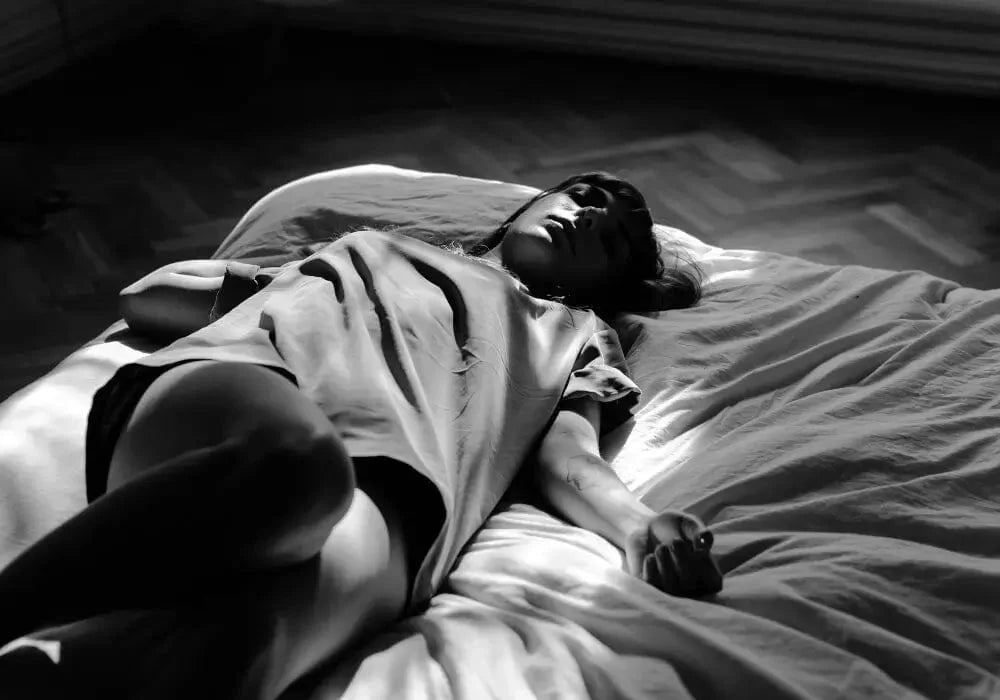
What is restless legs syndrome and how is it linked to menopause?
Exploring the connection between restless legs syndrome and menopause, what it feels like and what you can do to relieve it.
Restless legs – known medically as restless legs syndrome (RLS) or Willis-Ekbom disease – is an overwhelming urge to move your legs, usually when you’re in bed. It’s often accompanied by uncomfortable or even painful sensations in your legs and involuntary leg movements.
Restless legs syndrome is twice as common among women as men and you’re more likely to experience it during perimenopause or after menopause. RLS is also associated with other menopause symptoms, like night sweats.
In some cases, fluctuating oestrogen levels may contribute to restless legs syndrome during the menopause transition. RLS can also be related to iron deficiency, which some women may experience during perimenopause.
We’ll explore all of this in more detail below, as well as looking at treatments and lifestyle changes that could help to improve or prevent your symptoms – plus what you can do if you need more immediate relief from restless legs.
The Better Gut probiotic supplements can help with a wide range of perimenopause and menopause symptoms, from night sweats and poor sleep to anxiety and brain fog.
For extra support with sleep and anxiety, you can also try Better Night's blend of science-backed herbal ingredients, vitamins and minerals.
What causes restless legs during menopause?
Menopause is the point in time 12 months after your last period. Perimenopause is the years leading up to menopause when your levels of reproductive hormones such as oestrogen are in a state of flux.
During perimenopause and after menopause, you’re more likely to experience restless legs syndrome and your symptoms may be more severe.
Scientists tend to divide restless legs syndrome into two types, primary and secondary RLS.
Primary, or idiopathic, restless legs syndrome isn’t generally linked to other health issues but it often runs in families, so genes are probably a factor.
Secondary restless legs syndrome is usually associated with other conditions or changes in your body, such as iron deficiency or pregnancy, as well as perimenopause and menopause.
Although the relationship between restless legs syndrome and the menopause transition is not fully understood, there are several strands of evidence that provide clues as to how they could be linked.
Oestrogen and dopamine
Some scientists think restless legs syndrome could be related to the way your body deals with the neurotransmitter dopamine. This chemical messenger is involved in the movement of your muscles and could be behind the leg spasms that are often associated with RLS.
Fluctuating or increased levels of oestrogen during perimenopause may interfere with the functioning of dopamine. This could partly explain why RLS is common during pregnancy, when oestrogen levels are also changing.
On the other hand, RLS is no less common after menopause – when oestrogen has settled at its lowest – than it is during perimenopause. So although oestrogen probably plays a role in RLS during these times, scientists don’t yet fully understand the complexities.
Iron deficiency
The link between iron deficiency and restless legs syndrome may also involve dopamine – and could also be linked to menopause.
Reduced levels of iron are another change that may disrupt the functioning of your body’s dopamine system.
This could explain not only why RLS is more common in pregnancy, when many women experience iron deficiency, but also during perimenopause, when the increased blood loss from heavy periods can lead to low iron.
Risk factors for developing restless legs syndrome
Although the causes of restless legs syndrome can be varied and complex, we do know that a number of factors increase your risk of developing RLS, including several that are linked to menopause.
You’re more likely to experience restless legs syndrome if:
- you’re a woman
- you’re over 40
- you’re going through perimenopause or have reached menopause
- you’re pregnant
- you had RLS when you were pregnant
- RLS runs in your family
- you get night sweats during menopause
- you have an iron deficiency
- you have kidney failure, diabetes, Parkinson’s, rheumatoid arthritis, an underactive thyroid or fibromyalgia
Risk of developing RLS also increases as you get older.
What are the symptoms of menopause restless legs?
The main symptom of restless legs syndrome is an irresistible urge to move your legs. It most often happens in bed at night, or when you’ve been sitting for a long time.
The need to move your legs is often due to an uncomfortable sensation on your skin, or in your legs, such as:
- tingling
- crawling
- tugging or pulling
- fizzing
- burning
- itching
- throbbing
- cramping, especially in your calves
These sensations can range from mild to unbearable. Some people also get them in their arms or chest.
As many as 80% of people with restless legs syndrome also experience periodic limb movements (PLM) – sudden, involuntary jerking or twitching of their legs or arms. At night, they’re often violent enough to wake you and even your partner.
It’s no surprise that RLS is linked to sleep disturbances but there’s evidence that this is particularly true during perimenopause. There’s also a strong association between RLS and another menopause symptom, night sweats.
People with RLS may also have a higher risk of anxiety, depressed mood and migraines.
Treatments and prevention for restless legs syndrome
Depending on what’s causing your restless legs syndrome, the following approaches may help:
- Iron supplements: If your restless legs are linked to iron deficiency anaemia, taking iron supplements could improve things. Other symptoms of iron deficiency anaemia include tiredness and low energy, shortness of breath, heart palpitations and headaches.
- Dopamine agonists: If you get regular bouts of RLS, your doctor may prescribe medications that increases your dopamine levels. These include ropinirole and pramipexole, which come as tablets, and rotigotine, which is delivered via a skin patch.
- Pneumatic compression devices (PCDs): These inflatable cuffs go around your legs to increase blood flow. In small studies, using PCDs for an hour a day significantly reduced participants’ RLS symptoms after a few days or weeks, with some reporting that their symptoms disappeared completely.
- Exercise: The NHS recommends regular exercise for people with RLS and research backs this up. In one small study, participants did a 30-minute walk, as well as a series of resistance training exercises for their legs, 3 times a week. After 6 weeks, the severity of their symptoms had reduced by 39%.
- Sleep hygiene: Improving your bedtime routine may not tackle the causes of RLS, but it can stop it from interrupting your sleep so much. Stick to a regular bedtime, ditch electronic devices before bed, keep your room cool, dark and quiet and avoid caffeine, alcohol and tobacco.
How to stop restless legs quickly
The approaches above may help to prevent restless legs syndrome but during an episode of RLS you might need more immediate relief.
The NHS recommends the following:
- Massaging your legs or affected areas
- Stretching or walking
- Applying a hot compress to your leg muscles
- Taking a hot bath
Certain painkillers can also help with RLS. You can get mild opiate painkillers like codeine from a pharmacy. The codeine is often combined with another painkiller, such as ibuprofen. You should only use these for short-term relief as it’s possible to become addicted to codeine. If your symptoms continue, talk to your doctor.
Your doctor may also prescribe drugs sometimes used to treat epilepsy, such as gabapentin and pregabalin. These can help relieve both the discomfort and limb movements associated with RLS.
Does HRT help with restless legs?
Hormone replacement therapy (HRT) is a treatment that uses tablets, gels or skin patches to replenish reproductive hormones like oestrogen that are lost during menopause.
HRT can improve a range of common menopause symptoms but there’s currently not much evidence that it can help with restless legs syndrome. One small study actually suggested that HRT may make RLS worse, but other studies haven’t found this link.
We’ve already seen that the relationship between oestrogen levels and RLS is likely to be a complex one, and may in some cases be related to changes or increases in oestrogen levels, rather than simply low levels. In that case, boosting oestrogen with HRT might not be the right approach.
Nevertheless, HRT can improve sleep quality during menopause, which could be important if RLS is keeping you awake.
Your doctor can help you to decide whether HRT might be a good idea for you.
Summary
Restless legs syndrome is the overwhelming need to move your legs, usually at night or after sitting still for some time. It can be accompanied by a range of unpleasant or painful sensations, from tingling to cramping, as well as leg spasms.
RLS is more common during perimenopause and menopause. Causes can vary, but may include the effect of fluctuating oestrogen levels on dopamine, as well as iron deficiency.
RLS is also associated with menopausal night sweats, and can run in your family.
Depending on the cause of your RLS, a doctor may recommend iron supplements, dopamine antagonists or certain epilepsy drugs to reduce your symptoms. Pneumatic compression devices may also help, while getting regular exercise can lead to significant improvements.
For short-term relief from RLS, the NHS suggests massage, stretching, hot compresses or painkillers containing codeine.
The Better Gut probiotic supplements can help with a range of menopause symptoms, including poor sleep, night sweats and anxiety.
For extra support calming your mind and improving your sleep, add Better Night's expert-formulated blend of herbal extracts, vitamins and minerals.
Visit The Better Menopause and use discount code WELCOME10 for 10% off your first order.


